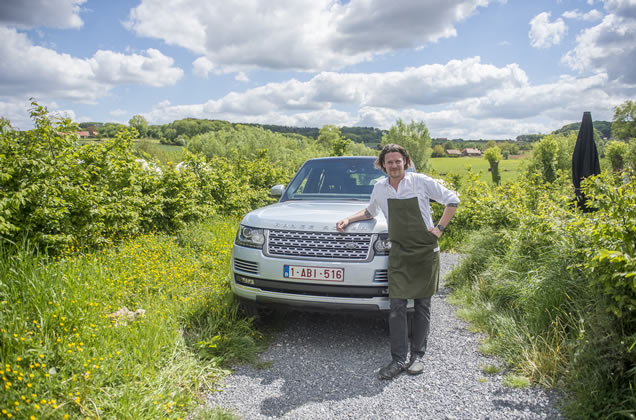Martin Banks spent the day been driven in a Land Rover to meet some eco-conscious entrepreneurs.
The link between a €100,000 car and a Flemish camp site may not seem immediately obvious. But, contrary to what you might think, there is rather more connecting the two than meets the eye. Here’s a clue: Ecology.
Respect for the environment is at the heart of the said camp site – it’s rather chic, up market ‘glamping’ (glamourous camping), and the same applies to the latest model from Range Rover.
The glamorous ‘Eco-Chique’ glamping, at Westouter, near Ypres, seeks to promote an ecologically-friendly approach to holidaying and camping. It does so, for instance, by using only recycled water and local products. Even the grass is allowed to grow as that is considered better for the environment.
Range Rover, the most luxurious Land Rover, is doing much the same, albeit in a slightly different way with its new Hybrid and Sport models. A luxury brand it may be, but this doesn’t mean these vehicles, both with off-road capabilities, cannot incorporate the latest environmentally-friendly features. And they very much do.
The Hybrid, for example, boasts a new, smaller-than-normal electric engine that only kicks in when you accelerate. This energy-saving facility is good for one’s pocket and the environment alike. About 600,000 vehicles roll off the famous carmaker’s assembly lines each year and ecology is fast becoming a top priority for the company, which is now, after an unsuccessful flirtation with Ford, owned by an Indian conglomerate.
Range Rover and Eco-Chique are not alone when it comes to combining luxury and ecology. One other Belgian company doing exactly the same thing is Gribani, which produces exclusive small hand-made leather accessories such as wallets, key rings, belts and I-phone cases. The unique selling point here is that the leather it uses is naturally tanned, meaning that chemicals are not used at any part of the production process. The items it produces at a factory in Tuscany are simple in design but, according to German-born Grit Nijhof, who co-founded the company with her husband in 2010, “very careful to respect nature.”
Across West Flanders is another prime example of how a quality product can be made whilst fully respecting the environment. Entre-deux-monts (so named because it is situated between red and black hills) is a 13-hectare vineyard run by winemaker Yves Bacquaert and his son Martin.
As Martin explains, their “environmental protection” business model is not dissimilar to Range Rover.
“Our belief is that all of us should try to work in a sustainable way,” he says, adding, “and with everything we do here we are trying to minimize our ecological footprint”.
How do they do that? Well, Yves and Martin use the lightest possible bottles for their white and sparkling wines, only solar energy is used in all their “energy efficient” buildings and all production is free from the use of insecticides or pesticides. “It all makes for sustainable winegrowing,” says 66-year-old Yves.
At present, Entre-deux-monts produces 30,000 bottles of wine annually. Some 30% is sold on the estate itself, 30% to restaurants and 30% to specialized wine shops.
Yves, who planted his first vines on the site ten years ago, expects this to rise to 60,000 bottles per annum.
His near neighbour is the go-ahead Robert Du Wolf who runs the aforementioned Eco-Chique which comprises 10 ‘domes’, or tents, in a spacious Flemish meadow. Opened four years ago, the site is primarily a holiday destination for couples (and families) but has increasingly become attractive for business clients who also want to sample its eco-friendly approach to tourism.
48-year-old Dutch-born Robert, who quit his staid white-collar management job in pursuit of The Great Outdoors, is particularly keen to promote the site’s dependence on a special natural water filter system which produces water for everything from the wellness centre to sanitary units.
“Like a hotel we have a swimming pool for guests but we call it a bio pool. Its water is so pure and natural that even the birds drink from it,” he says. Anyone tempted to try this hotel in the nature (motto: “glamping with a smile”) should beware: Eco-Chique is already heavily booked for summer.
On a smaller scale, but still flying the flag for the environment, is Eduard Bartels who has produced an eco-novelty – heated outdoor benches. Apart from being rather useful in our inclement weather, the ‘Eddyboy’ benches are heated (up to 30˚C) from water which is sourced from things like dishwashers and central heating.
The stylish benches are intended both for the catering and hospitality sectors and private use. Eduard says: “Many of us are familiar with those outdoor heated appliances used in restaurants and cafes but I think this offers something new and different. The costs are low and is it also energy-friendly so I guess it ticks all the boxes.”
Building company EX-IT is yet another striking example of a Belgian company showcasing an excellent version of eco-luxury. In this case, the end result is what the company calls “energy neutral” buildings. In layman’s language, this means newly-constructed buildings that incorporate energy-efficient materials, such as solar power and geothermal heating systems.
Such materials are less sensitive to the passage of time and, as such, allow its constructions to enjoy a longer lifespan. One typical example is an EX-IT guest house at Lokeren, constructed by the company and where the use and even colour of its building materials are in perfect harmony with the local wooded surroundings.
Range Rover is keen to highlight the efforts it and companies like EX-IT are making to protect our increasingly-threatened climate. Its large, luxury four-wheel drive sport utility vehicle is the flagship model of the Tata Group. Launched in 1970, it is now in its fourth generation.
The reduced weight of the new Hybrid model (average price €100,000) reduces consumption. It is made, mostly, from aluminum which also extends the lifespan of each vehicle. Even interior features, such as the carefully hand-stitched leather dashboard, seek to be eco-friendly.
Isabelle Michiels, PR Manager for Jaguar Land Rover Belux, said: “We are very proud to introduce the Hybrid models on Range Rover and Range Rover Sport which each have impressive consumption figures of 6.4 litres/100km.
“Our commitment to be a sustainable business reaches far beyond the improvement of the environmental performances of our cars. Land Rover invests in sustainability on all levels of its business and proves that luxury and environmental responsibility do not exclude one another. It is a real pleasure to tell this story with the help of Gribani, Eco Chique, Eddyboy, Entre Deux Monts and EX-IT, all beautiful luxury brands led by passionate people with a heart for the environment.”
Comparisons between Range Rover and some of its informal, eco-friendly “partners” may, at first, seem tenuous and, of course, firms like Eddyboy can only dream of becoming the design icons of Range Rover. Even so, each in their own way is trying to bring a sustainable approach to the way they operate and that can only be a good thing.







